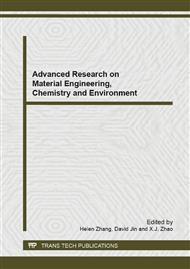p.114
p.119
p.127
p.132
p.136
p.141
p.147
p.152
p.159
Unmodified Goldnanoparticles Used as Probes for Detection of Coralyne with poly(A40)
Abstract:
Coralyne is a kind of protoberberine alkaloids with strong anticancer activity in animal models, which could induce single-stranded adenine rich nucleic acids (poly (dA)) to form a duplex structure. And poly (dA) could be absorbed on the surface of gold nanoparticles (AuNPs) to enhance the stability against NaCl induced aggregation. However, coralyne induced poly (dA) to form double-stranded DNA, which then left the AuNPs resulting in the arrgregation by NaCl. This paper investigated the conditions and effects of using poly (A40) as a probe for the coralyne detection. The detection of coralyne used 100 mM HEPES and 200 mM NaCl as the buffer solution. The poly (A40) was 250 nM in the experiment for the protection of AuNPs aggregation caused by buffer solution. UV-visible spectroscopy was employed to detect the colorimetric changes in the aggregated condition of AuNPs. From blank to 1000 nM of coralyne, a linear response was obtained with R2 = 0.862. The limit of detection was 100 nM. Results showed that the detection of coralyne with poly (A40) was achievable by using unmodified AuNPs.
Info:
Periodical:
Pages:
136-140
Citation:
Online since:
September 2013
Authors:
Keywords:
Price:
Сopyright:
© 2013 Trans Tech Publications Ltd. All Rights Reserved
Share:
Citation:


